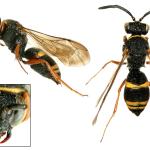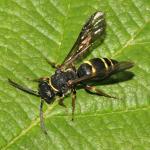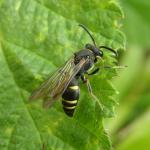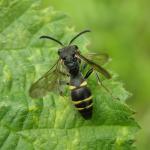Crabro spinosus Fabricius, 1775; Mellinus tricinctus Fabricius, 1793; Vespa trilineata Turton, 1802; Nysson geniculatus Lepeletier, 1845; Nysson malaisei Gussakovskij, 1932
Much information on the behaviour of Nysson and related genera is given by Evans (1966), although the nomenclature is now out of date.
Widespread in England and Wales, from Cornwall to Kent and north to Durham. There are several recent records from Scotland, from Ayrshire to East Ross. Also east and south-west Ireland (Richards 1980). Abroad, the species is found in most European countries, in Siberia east to Primor'ye, and Japan (Lomholdt, 1975-76).
This species is not regarded as being scarce or threatened.
Occurs in the same habitats as its host species, Argogorytes fargei and, particularly, A. mystaceus.
Univoltine; May to July (Richards, 1980).
The species is not predacious, but a cleptoparasite of Argogorytes species (Richards, 1980).
The female Nysson finds the host nest by scent, enters the burrow and lays an egg on the prey at the bottom of the cell. After hatching, the Nysson larva destroys the host egg and feeds on the stored prey.
In Britain, the wasp has been seen on umbellifers (Apiaceae) and common bird's-foot-trefoil (Lotus corniculatus); also on wood spurge (Euphorbia amygdaloides) (M Edwards, pers. comm.). Abroad it is reported to visit field scabious (Knautia arvensis), devil's-bit scabious (Succisa pratensis), sheep's-bit (Jasione montana) and several umbellifers (Lomholdt, 1975-76).
It is likely that Nysson spinosus is occasionally hyper-parasitised by miltogrammine sarcophagid flies.
2001
Proofed: March 2012





